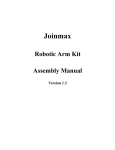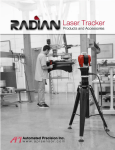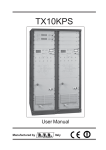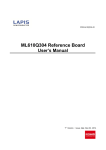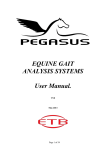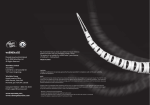Download 2.3. Assembly Steps
Transcript
JOINMAX DIGITAL QUADRUPED ROBOT KIT Assembly Manual Version 1.2 1 CONTENTS CONTENTS ..................................................................................................................................... 2 CHAPTER 1 BRIEF INTRODUCTION...................................................................................... 3 1.1. WHAT IS THE JOINMAX QUADRUPED?........................................................................................ 3 1.2. WHY TO ASSEMBLE QUADRUPED?............................................................................................. 5 1.3. PACKAGE LIST ............................................................................................................................ 5 CHAPTER 2 HOW TO ASSEMBLE? ......................................................................................... 5 2.1. PREPARE TO WORK .................................................................................................................... 5 2.1.1. REQUIRED TOOLS .................................................................................................................... 5 2.1.2. ABOUT POWER SUPPLY ........................................................................................................... 6 2.2. ASSEMBLY PARTS LIST ............................................................................................................... 6 2.3. ASSEMBLY STEPS ....................................................................................................................... 8 2.3.1. LEG ASSEMBLY ....................................................................................................................... 8 2.3.2. BOTTOM BOARD MODULE ASSEMBLY .................................................................................. 11 2.3.3. TOP COVER MODULE ASSEMBLY .......................................................................................... 11 2.3.4. MAIN BODY ASSEMBLY ........................................................................................................12 2.3.5. MAIN CONTROL BOARD AND BATTERY CABINET ASSEMBLY ...............................................15 2.3.6. LOAD BATTERIES ..................................................................................................................17 CHAPTER 3 HARDWARE DESCRIPTION ............................................................................ 18 3.1. BASIC KNOWLEDGE OF MINI-SERVOMOTOR ............................................................................ 18 3.1.1. BRIEF INTRODUCTION OF MINI-SERVOMOTOR ...................................................................... 18 3.1.2. INTERNAL STRUCTURE OF MINI-SERVOMOTOR .....................................................................18 3.1.3. WORKING THEORY OF MINI-SERVOMOTOR .......................................................................... 19 3.1.4. HOW TO CONTROL SERVOMOTOR ......................................................................................... 20 3.1.5. POWER SUPPLY WIRES OF SERVOMOTOR ...............................................................................21 3.1.6. THE SPEED OF SERVOMOTOR ................................................................................................ 21 3.1.7. NOTICES FOR SERVOMOTOR USAGE ...................................................................................... 21 3.2. JMSC16 SERVOMOTORS CONTROL BOARD DESCRIPTION ....................................................... 22 3.2.1. WHAT IS THE JM-SSC16 ....................................................................................................... 22 3.2.2. SPECIFICATIONS OF JM-SSC16 ............................................................................................. 22 3.2.3. JM-SSC16 WORKING ENVIRONMENTS .................................................................................23 3.2.4. PORTS OF JM-SSC16............................................................................................................. 23 3.2.5. CONNECTING CABLE BETWEEN JM-SSC16 AND PC SERIAL PORT ....................................... 24 6. RS232 COMMUNICATION PROTOCOL OF JM-SSC16................................................................... 25 3.3. BRIEF INTRODUCTION OF MINI SERVO EXPLORER ................................................................... 26 3.4. THE CONNECTION BETWEEN SERVOMOTOR AND JM-SSC16 ..................................................27 CHAPTER 4 GAIT ANALYSIS.................................................................................................. 28 4.1. GAIT OF GOING FORWARD OR BACKWARD ..............................................................................28 4.2. GAIT OF TURNING LEFT OR RIGHT ...........................................................................................30 2 Chapter 1 Brief Introduction Congratulations on your smart purchasing of the Quadruped robot kit delivered by Joinmax Digital Tech. This kit will be sure to satisfy your desire for robotic study no matter you are a newcomer or a seasoned veteran. This kit includes a complete set of the electronic and mechanical parts and basic control software. It will take you about 2 hours to set up a complete lively Quadruped according to the user manual, and base on it, you will be able to bring your imagination and creativity into play. To acquaint yourself with the excellent property of the Quadruped Monster and its correct assembling and control method, you are strongly proposed to read this manual carefully. If you have any comment or suggestion, please send us a letter or email through our web site, and its address is http://www.robotplayer.com. We'd love to hear from you. Your suggestion will be very helpful to the improvement of our robots. If you have a good case of playing the Quadruped Monster, please don’t hesitate to send us the jpg images and some necessary descriptions of it, we will publish them on our web site so that more players can share your success and joy. 1.1. What is the Joinmax Quadruped? The Joinmax bionic Quadruped Monster is a typical model for robot walking gait study, and it is a basic platform of walking robot. It can be applied in many fields such as research, education, entertainment etc. and it is also a good tool to expand your view and enhance your ability. You need to assemble the Quadruped Monster by yourself, and you should use more than 170 parts in it, this will challenge your intellect and handwork ability, but you will experience the pleasure through assembly and testing it. Through the software’s control, the Quadruped Monster will be able to simulate various behaviors of animals, and that will make the science theory visualizes more. The global appearance of Joinmax Quadruped Monster 3 Figure 1 Features: It is able to move flexibly because it has 8 Servomotors for the joints control. It is able to run fast because it has 4 Strong Legs lifting vertically and Turning horizontally. The gripper mounted on its head is able to clamp and deliver objects easily. It is high expansible because it adopts a general-purpose servo control PCB. It is easy to upgrade to 6 legs or 8 legs robot by adding parts. Through controlling its 8 servomotors precisely, it is able to simulate various walking gaits of the hexapod animals, such as rambling, quick walking, fast running, turning, spinning, etc. and is able to adjust its gaits to adapt different ground environments such as smooth ground, rough ground, sandy ground, or wet ground. It is even enable to do many A.I behaviors by means of the control circuit board. 4 1.2. Why to Assemble Quadruped? Through assembling the Joinmax Quadruped by yourself, you will be acquainted with the mechanical theory of walking, you will also learn how to control servo motor and operate software, and then you can master the skills to enable the Quadruped Monster to walk. 1.3. Package List 1. 42recise plastic modules and 40etallic parts, the total is 82eparate parts 2. 1 Mini servo controller board that can control up to 16 servomotors. 3. 8 precise servo motors. 4. 1 Joinmax Mini Servo Explorer CD for installation 5. 1 computer connecting cable 6. 1 battery cable 7. 1 assembly manual(You’re reading it) Chapter 2 How to Assemble? 2.1. Prepare to Work 2.1.1. Required Tools Before assemble the Quadruped, you must prepare the following tools: 1 1 cross screwdriver 2 1 tip pincers 5 2.1.2. About Power Supply Quadruped needs strong power supply which voltage is about 5 to 6 volts, so we suggest you to choose 5 rechargeable batteries which voltage is 1.2 volts each with large capacity and good quality. Please prepare 5 GP 1800mAh Ni-H AA/5 rechargeable batteries. At the same time you should prepare a good quality battery charger, for example, the “GP battery charger” which can be bought in the market easily. It can save your money because you can use these batteries repeatedly. WARNING! 1 Don’t use normal alkaline battery which voltage is 1.5 volts, and it will do harm to the electrics circuit of Hexapod Monster. 2 Don’t use any inferior or easy leakage batteries because any damages caused by batteries misuse are not covered under our guarantee. 3 Remember to use the batteries at least after half an hour after they are completely charged, otherwise it will hurt the control circuit because of high voltage. 2.2. Assembly parts List You will use the following parts in the assembly process, please array them. 1 M2.5×18 Tapping 2 M2.5×10 Tapping Screw TS1(8 Pieces) 3 Screw TS2(24 Pieces) .5×6 Tapping Screw TS3 (8 Pieces) 6 4 Long Leg (4 Pieces) 5 Servo hoop (4 6 Upper Limb A (4 Pieces) 9 Lower Limb B (4 Turning Board (4 Upper Limb B (4 Pieces) 10 Pieces) 13 7 Lower Limb A (4 Pieces) Top Cover (2 11 Bottom Board (2 Pieces) 14 8 Pieces) 12 Connecting Board Pieces) Waist (2 pieces) 15 pieces) Battery cabinet (2 pieces) 16 cover (1 Battery Cabinet (1 Piece) pieces) 17 Servomotor 18 Main Control Board 19 Servomotor turning (1 arm (4 Pieces) (8Pieces) 20 to battery (1 piece) Piece) 21 connecting cable 23 Joinmax mini-servo 22 of wire connected 24 Assembly manual computer nylon cable Explorer software button (1 Piece) (1 piece) CDrom (1 Piece) (5 piece) you’re reading 7 2.3. Assembly Steps We suggest you to check up the types and quantities of all parts first, and then you had better follow the illustrations below strictly to assemble the Quadruped Monster, and pay attention to the relative warning. 2.3.1. Leg Assembly Assembly Quantity 2 Right Legs and 2 Left Legs Parts List (For each leg): No. Part name Quantity No. Part name Quantity 1 2 M2.5×10 TS2 6 6 9 2 4 Long Leg 1 7 13 Turning Board 1 3 6 Upper Limb A 1 8 17 Servomotor 1 4 7 Upper Limb B 1 9 19 Servomotor turning 1 Lower Limb B 1 arm 5 8 Lower Limb A 1 WARNING: Make all the screws face to same direction for better appearance. Pay attention to the assembly direction of “(10) Lower Limb A” (Illustration 3). There is a deeper hole at one side, you had better make the screw cap sink inside the hole, and face outside when assemble. The wrong fixing will affect the activity of the whole leg. 8 Right Leg Assembly Steps 1 2 3 4 5 6 7 8 9 Left Leg Assembly Steps 1 2 3 4 5 6 7 8 10 2.3.2. Bottom Board Module Assembly Assembly Quantity Parts List 2 No. Part Name Quantity 2 1 5 Servo hoop 2 11 Bottom Board 1 3 17 Servomotor 2 4 Left Leg Module 1 5 Right Leg Module 1 Assembly Steps 1 2 2.3.3. Top Cover Module Assembly Assembly Quantity: 1 Parts List No. Part Name QUANTITY 1 (10) Top Cover 2 2 (14)Waist 1 3 (12) Connecting Board 2 11 Assembly Steps 1 2 2.3.4. Main Body Assembly Assembly Quantity: 1 Parts List: No. Part Name Quantity 1 (1)M2.5X18 TS1 8 2 (14)waist 1 3 Top Cover Module 1 4 Bottom Board Module 2 12 Assembly Steps 1 Before you put the waist into the anchor slot on the top cover, please install all connecting lines of the servomotors into the line pipe of the waist first, let all the lines pass through the hole on the top cover as below and then pack up the cables with nylon cable button. . 13 2 Before assembly, you had better let the connecting lines of servomotor pass through the holes of the cover and bottom board as below. 14 3 2.3.5. Main Control Board and Battery Cabinet Assembly Assembly Quantity: 1 Parts List: No. Part Name Quantity 1 3 2 15 Battery Cabinet Cover 1 3 16 Battery Cabinet 1 4 18 Main Control Board 1 5 M2.5X6 TS3 8 Main Body 1 15 Assembly Steps 1 2 16 2.3.6. Load Batteries 1 2 Load 5 AA/Size rechargeable batteries in the cabinet as above, the poles should be in accordance with the illustration. 3 4 Close and lock the cover Now, you have completed assembly of Quadruped. 17 Chapter 3 Hardware Description 3.1. Basic Knowledge of Mini-Servomotor 3.1.1. Brief introduction of Mini-Servomotor Many people think it is very difficulty to make a robot. But in fact, making a personal robot is not more difficult than making a car model, further more it will enable you to experience another kind of pleasure, expand your view, and elicit your inspiration. In the following we will introduce briefly the working theory and controlling way of the mini-servomotor which is the most comment intelligent part for personal robot. Mini-servomotor has been used quite widely in radio amateurs’ models for a long history. It is a main part for controlling the moving directions. Servomotor is a kind of motor used for positioning which is able to move to the designated position after receiving an order. So it is used to control the joints in the robot model, and we call these joint the degree of freedom. The servomotor has the following advantages: large torque, easy control, flexible assembly, inexpensive. But it also has some disadvantages: firstly, it is an precise machine, which will be damaged when being overloaded. Secondly, there is an electronics control circuits inside, which will be destroyed by incorrect connecting. So it is necessary to understand how theyr works before we use them to avoid losses. The servomotors displayed in the pictures of this manual are Vigor’s servomotors which designed for robot model usages specially and they have many advantages: large torque force, good performance, lower price etc, and are suitable for robot amateurs usages. 3.1.2. Internal structure of Mini-Servomotor A servomotor is constructed by a small D.C. motor, a series of gears, a feedback potentiometer (variable resistor) for position adjustment purpose and an electronic control board. The high speed D.C. motor provides original power to the gears which provide the large 18 torque. The higher is the speed ration the gears’ convert, the stronger is the torque. That means it can carry higher load but its turning speed is slower. series of gears Feedback variable resistor DC motor electronic control board 3.1.3. Working Theory of Mini-Servomotor A mini-servomotor is a typical closed loop feedback system, and its theory is demonstrated as below: The speed reduction gears case are driven by the D.C motor, and its output drives a variable resistance varying linearly which acts as a position detector and transforms the degrees of turning angle into a voltage and feed it back to the control circuit board which compares the voltage to the input controlling pulse signal, then an adjusting pulse will be produced to drive the motor turning forward or backward and make the adjusting pulse becomes zero, so that the servomotor moves to the designated position. 19 3.1.4. How to Control Servomotor A standard mini-servomotor has three control wires which is power, GND and control line. The power wire and GND are used to supply the power to the D.C. motor and the control circuit. The power should be between 4V-6V and separated from the one of processing system because the servomotor will cause high frequency noise and sometimes, even a small servomotor can lower the voltage of the amplifier when it is loaded highly, so the configuration of the power supply should be reasonable. Normally, the servomotor requires a high pulse of 1ms to 2ms in period and a low pulse of 5ms to 20ms in period which is not very strict. The illustration below demonstrates the relationship between the pulse length and the mini-servomotor output shaft position, the period of pulse is 20ms. Input pulse width (T=20MS) Servo position 0.5ms - 90º 1.0ms - 45º 1.5ms 0º 2.0ms 45º 2.5ms 90º 20 3.1.5. Power Supply wires of Servomotor Control Wire (Yellow) SERVO Power (Red) GND (Black) The yellow one is control wire which should be connected to control chip. And the middle one is power supply wire, and the power is usually 5 volt. And the third one is GND. 3.1.6. The Speed of Servomotor The instant speed of servomotor depends on the coordination between the internal D.C. motor and the gears and remains unchanged under a constant driving voltage. But its average speed can be changed by inserting stop points between the start position and the designated position. For example, we can divide a distant of 90 degrees into 128 stop points, and lengthen the stop time in each stop points to slow down the average speed of servomotor because to most servomotors, the unit of the speed is “degrees/second”. 3.1.7. Notices for Servomotor Usage The shaft position of servomotor is not so accurate unless it is a digital servomotor. The normal servomotors are not precise positioning devices, and the differences 21 between them vary largely, even they are of the same brand or model. So it is normal that different servomotors have 10 degrees deviation under the same driving pulse. Because of the mention above, it is not recommended that don’t use a driving pulse less than 1ms or larger than 2ms. And in fact, the turning range of servomotor original designed is within 45 because the linear relationship between the pulse length and the turning angle will become worse when the turning angle exceed 45 . Warning: Do not use a pulse which will drive the servomotor turn out of 90 range. Otherwise, the servomotors mechanical stop or the gears will be damaged. There is no standard for servomotors output shaft degrees and control pulse length, so you need to adjust the parameters in the control software based on different servomotors. 3.2. JMSC16 Servomotors Control Board Description 3.2.1. What is the JM-SSC16 JM-SSC16 (JoinMax-serial servo controller) is a small pre-assembled circuit board dedicated controlling up to 16 servos from a micro-controller or PC serial port. The servos can be easily positioned by sending simple instructions written by your own or just by our software: JoinMax Mini Servo Explorer. 3.2.2. Specifications of JM-SSC16 MPU AVR Series ATmega16 CPU oscillator: 8 MHz Serial input = RS-232 or inverted TTL/CMOS, 9600, N81 PC interface: Modular RJ11 port Output Ports to Servomotors Up to 16 servos plug in directly Servo type supported: VIGOR FUTABA and HITEC Output Pulse T=20MS VH=0.5~2.5MS 22 Servo travel range: 180° Servo resolution: 0.72° / step PCB Size 53×60mm( 2.1" x 2.36") Power Supply +5V For Logical Circuit +6V For Servomotor GND Current requirements (logic): about 26mA 3.2.3. JM-SSC16 Working Environments JM-SSC16 working environments are demonstrated as below: Robot Mech. Up to 16 Construction servomotors JM-SSC16 PC Servomotor MCU control board control or sensors board Power supply Power supply: Includes the power supply of the control system (+5 volts) and that of servomotor (+6 volts). If you want to use only one power supply, you must keep the voltage between 5.0 volt and 5.5 volt, and short the jumper J4. 3.2.4. Ports of JM-SSC16 23 Pinouts on JM-SSC16 Note: You must set an ID number to the control board before it is used. The ID number should be NO.1 if you use only one board, The DIP switch setting for NO.1 is shown as below: DIP switch (NO.) ON OFF 1 2 3 4 There are two operation modes for the Mini-servo Control Board: Operation Mode Condition Operation On-line mode 1. It’s connected to the PC It’s on-line controlled by RS232 port via download Mini-servo Explorer program. cable. 2. Mini-servo Explorer has been run on the above PC. Off-line mode 1. No cable is connected to It will run the actions which its RS232 serial port. being edited and downloaded 2. 4 seconds after powered on by Mini-servo Explorer at the or being reset. last time. 24 3.2.5. Connecting Cable between JM-SSC16 and PC Serial Port Specification of the cable: Illustration Pinouts DB9F Connector to PC COM port RJ11 Connector DB9F 5 RJ11 1 -GND DB9F 2 RJ11 2 -TXD DB9F 3 RJ11 3 -RXD DB9F 5 RJ11 4 -GND to JM-SSC16 6. RS232 Communication Protocol of JM-SSC16 Real-time control: Byte sequence 1 2 3 Value 0xff Servo NO. 0~15 Servo position 0~250 25 3.3. Brief Introduction of Mini Servo Explorer Mini Servo Explorer is the specially designed control software based on Windows for JM-SSC16 which has many good features such as visible interface, easy to operate, and they will be demonstrated as below: 1 The upper limit and the lower limit of servomotors can be set separately according to the parameters or environmental conditions of each servomotor. 2 You can control any servomotor in the system separately, and make them work separately or work together harmoniously. 3 You can make the servomotor move to the designated position at the highest speed, or you can make it move smoothly to there by setting its speed factor. 4 The servomotor can be controlled by inputting the value of position or drawing scrollbar on the interface. 5 The graphical user interface is friendly and is easy to operate, and the software also provides many useful functions. 6 You can modify the unsatisfied actions of the robot while you are playing it, and you can also edit the actions in the PC without connecting robot. 7 It is very convenient to modify the actions of the robot because you can store the edited actions for later usage or link up many separate actions into a complete set of actions. 8 The software has many powerful functions, and lively samples. Please read the manual or online help of Mini Servo Explorer for more details. 26 Servo Servo Servo Servo Function Position Servo Servo Function Channel# Position Channel# Right Vertical Servo 1 Left Rear Vertical Servo 9 Rear Leg Horizontal Servo 2 Leg Horizontal Servo 10 Right Vertical Servo 7 Left Vertical Servo 15 Front Leg Horizontal Servo 8 Front Leg Horizontal Servo 16 3.4. The Connection Between Servomotor and JM-SSC16 Vertical Servo Right Rear Leg Left Rear Leg Right Front Leg Left Front Leg Horizontal Servo 27 Chapter 4 Gait Analysis All actions of Hexapod Monster can be edited by customer. And we provide a sample of Gait Analysis as below. 4.1. Gait of Going Forward or Backward Quadruped needs a tripod to stand, otherwise, it will tumble. So we must use three legs of Quadruped to make a tripod. There are 4 steps for the Quadruped to walk forward or backward. To walk forward, follow the step 1, 2, 3, 4 then repeat. And to walk backward, follow the step 4, 3, 2, 1 then repeat. Leg Number Step 1 Step 2 Step 3 Step 4 1 Lift, Backward Land, Forward Land ,Forward Land ,Backward 2 Forward Land, Backward Lift, Backward Land, Forward 3 Land ,Forward Land ,Forward Land ,Forward Lift, Forward 4 Land, Backward Lift, Forward Land, Forward Land ,Backward 3 4 2 1 Step 1 28 Step 2 Step 3 Step 4 29 4.2. Gait of Turning Left or Right The Quadruped should take 4 steps to turn left or right. It can repeat these 4 steps keep turning, and I can repeat these 4 steps in reverse to keep turning another direction. Leg Number Step 1 Step 2 Step 3 Step 4 1 Lift, Forward Land, Backward Land, Backward Land, Forward 2 Land, Forward Land, Backward Lift, Backward Land, Forward 3 Land, Backward Land, Forward Land, Forward Lift, Backward 4 Land, Backward Lift, Forward Land, Forward Land, Backward 4 3 2 1 Step 1 Step 2 30 Step 3 Step 4 You will find that these 4 steps can be divided into two parts: 2 main actions and 2 auxiliary actions. The main actions provide the propulsion, and the auxiliary actions keep the balance of body, so that the Quadruped will not tumble in any status because it has a tripod to support its body at any time. You can combine the auxiliary action and the main action together, try it and enjoy it! 31































